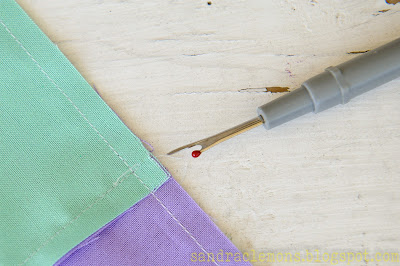Hello Friends,
Today, I'll talk about the direction to press your seam allowance in your blocks. This will come in handy when constructing the
Summer Sampler.
A quick intro on my quilting mechanics. I'll share how I assemble quilt tops. I hope you can take a thing or two away. So here we go...
First off, I don't starch or steam my blocks. (O no, I said it.) I don't, just never have, don't think I need too and it seems like extra stuff to do when I'm juggling my time as a mom and wife. Let me clarify, I don't steam my quilt until the entire top is constructed and has been pressed. Then I hit it with steam to really make sure my top is nice and flat. I do quilt my own quilts and spray baste.
I believe that steam, even if you press, can still distort your units. I work with a lot of bias and just don't want to take the chance. I'm all about efficiency in my mechanics. I believe that we can all be precise quilters. For example, there's no need to enlarge our cut pieces, just so we can add more steps to trim them down and worse, waste away beautiful fabric. To me, it's like throwing away money, because as quilters, we all know that quilting isn't a cheap hobby. Call this my quilting style or whatever, but this is what you can expect from my patterns.
What do I do instead of steaming, well, I finger press. I finger press until the entire block is assembled, then I press with my Oliso iron.
So why all this intro... Because it's important to understand a quilter's process and why they do the things that they do. For example, if you prewash all your fabric, then your process will be completely different than mine.
I'm very thorough and thoughtful of where to press seams. I want to make sure all my seams lock. I don't open seams. It's just not my style. I believe that when you open your seams, then you are leaving room for your quilt to pull apart as it wears. Plus, as quilters we work with a quarter inch seam allowance. That just doesn't seem like enough for me to open my seams.
I press my seams to one side. However, when you're working with many seams, there are times where all the seams create a large bulk. For example, the center of the Lemoyne Star Block. Large bulk can warp your points and make machine quilting difficult. Eek. We don't want that either.
I prefer to pinwheel my seams. I love it and I wish more quilters talked about it. I call it pinwheel, but others may call it circular or 4-patch.
(In my patterns, you'll see this box which explains how to pinwheel your seams.)
As I explain how to pinwheel your seams, I'll use this Hour-Glass unit in the center of the block. The rest of the instructions are from
week 3 of the Summer Sampler.
Referring to the digital diagram below as part A (left), B (middle), and C (right). After part A is constructed we now have part B, where you see a circle with arrows in it. This symbol represents the moment to pinwheel the seam after stitching.
At this moment, we pull a stitch or two from the intersecting stitch of part A when stitching part B.
Then, finger press the seam from part B. Sometimes you'll have to wiggle out the center of the unit a bit, but that's expected. Notice how all the seams route in one direction, similar to a pinwheel effect.
There you have it. A pressed pinwheel seam. You'll start to notice as you put your quilts together, that there's many more opportunities to pinwheel your seam direction to ensure locked seams during assembly.
Till next time,
Sandra






















































